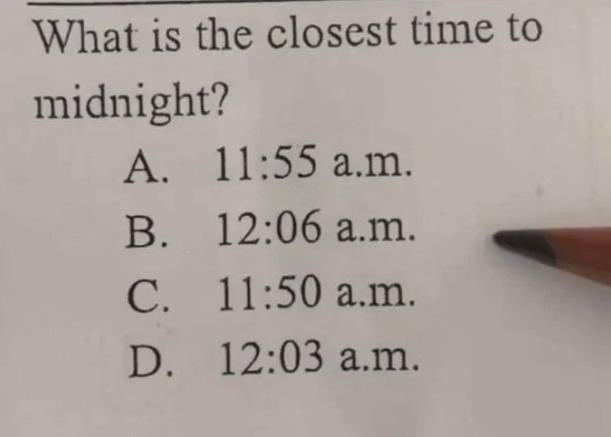Everyone loves a good brain teaser, and recently, a math puzzle has taken the internet by storm. Originally created for children, this puzzle has captivated people of all ages and sparked an extensive debate online. It all started on Reddit, where a seemingly simple question turned into a global conundrum, challenging everyone’s problem-solving skills and sparking lively discussions worldwide.

In June 2023, a Reddit user from Jamaica, known as @yawdmontweet, posed a puzzling question: “What is the closest time to midnight?” The options given were:
- A. 11:55 a.m.
- B. 12:06 a.m.
- C. 11:50 a.m.
- D. 12:03 a.m.
What seemed like an easy question quickly snowballed into a viral debate, garnering over 1.4 million views and countless comments. The wording of “closest time to” left enough ambiguity that it could be interpreted in several different ways, making this puzzle a hot topic across social media and forums.
The Debate on Reddit
A large portion of Reddit users leaned toward option D—12:03 a.m.—as the closest time to midnight. The reasoning was pretty straightforward: 12:03 a.m. is just three minutes past midnight, making it the nearest time after midnight. Many felt that the answer was obvious, as it was simply the first moment right after midnight.
However, not everyone agreed with this conclusion. Some argued that the wording of the question—specifically, “closest time to” rather than “closest time after” or “closest time before”—left room for interpretation. For example, option A (11:55 a.m.) could be considered the closest time to the upcoming midnight when looked at from the perspective of the current time being in the morning. From this viewpoint, 11:55 a.m. is closer to midnight later that night than any of the other times mentioned.
Others approached the problem from a different angle altogether. They questioned whether the concept of “midnight” itself influenced the choice. Since option A is the closest time before the next midnight, some people argued that it should be viewed as having a closer relationship to midnight in general. It was this line of reasoning that divided people into various camps, with each side having a different way of interpreting what “closest to midnight” truly meant.
What Did AI Have to Say?
Amidst the chaos, some participants decided to consult artificial intelligence for a more definitive answer. ChatGPT, an AI chatbot, was called upon for its take. Without hesitation, ChatGPT declared option D—12:03 a.m.—to be the correct answer, reinforcing the sentiment of many that this time is indeed the closest to midnight since it occurs just three minutes after midnight.
ChatGPT’s answer seemed to align with the logical approach taken by many participants, but it didn’t end the debate. There were still those who insisted that the phrasing of the question allowed for other valid answers, depending on one’s interpretation. This continued debate showed that this wasn’t just a simple math problem; it was also a lesson in how different people can understand and interpret questions differently based on wording.
Breaking Down the Options
To clarify the different viewpoints, here’s a breakdown of each answer choice:
- Option A: 11:55 a.m.
Pros: From a broader perspective, this is the closest time to the next midnight, making it a reasonable choice if you consider the entire day’s timeline.
Cons: It’s not the closest time immediately after midnight, which makes it less appealing if you focus only on the short-term view. - Option B: 12:06 a.m.
Pros: It’s only six minutes past midnight, meaning it’s still quite close in proximity to midnight.
Cons: It’s farther from midnight than 12:03 a.m., which makes it a slightly less optimal choice. - Option C: 11:50 a.m.
Pros: It is before noon, indicating that it’s closer to the upcoming midnight than any time after.
Cons: It’s farther away from midnight compared to the other options, especially those that occur directly after midnight. - Option D: 12:03 a.m.
Pros: It’s only three minutes after midnight, which makes it the closest time to midnight, right after it strikes.
Cons: There aren’t many drawbacks to this choice, as it directly reflects the time just after midnight.
More Than Just a Math Problem
This math puzzle is more than just figuring out which time is closest to midnight; it’s also a reflection of how our minds work when we face problem-solving scenarios. It challenges us to think critically, consider different viewpoints, and even engage in lively debates. It serves as a reminder that sometimes the simplest questions can have the most complex answers, depending on how we interpret the context.
The viral math puzzle about the closest time to midnight has entertained us, but it has also served as a valuable lesson in critical thinking and interpretation. Whether you side with option D for its clear proximity right after midnight or are drawn to the arguments for other options, this puzzle is proof of the fun and challenge inherent in solving such questions.
Where Do You Stand?
So, which option do you believe is correct? Is 12:03 a.m. truly the closest time to midnight, or is there more nuance to consider? Perhaps there isn’t a single correct answer, and instead, it all depends on how you interpret the phrasing of the question. Dive into the debate, share your perspective, and see where you stand in this global brain teaser!
This article aims to engage readers by blending in-depth analysis, creative thought, and an invitation to participate in the discussion. It shows that puzzles are not just about finding the right answer—they’re also about the journey of reasoning, considering different possibilities, and enjoying the process of solving together.





